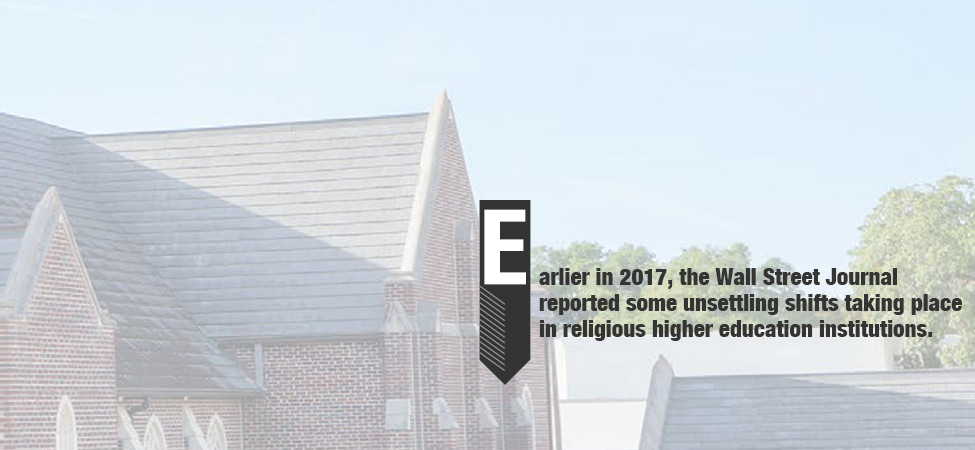A downward trend in enrollment can be traced over the past decade – an average of a 25% drop overall. The mainline seminaries that are experiencing this decline aren’t just suffering a temporary setback; some are closing their doors for good.
The past year has shown a number of seminaries closing or merging with other institutions as they struggle to cope with dwindling enrollment numbers. While some of the factors behind this are unique to religious institutions, others are universal to all higher education, and could be viewed as a premonition for other institutions if steps aren’t taken to avoid the same fate.
But to discover exactly what all institutions, both religious and secular, can learn from this very specific trend, we first need to know: What is causing the downturn in America’s seminaries?
The Source of the Downturn
The enrollment dropoff in religious higher ed is a result of a number of factors, not the least of which being a lower demand for pastorate roles. The once-popular Master’s of Divinity program, a requirement for most aspiring pastors, has decreased in popularity as there are simply fewer pastoral positions to be filled nationwide.
Instead, students who are interested in theological studies are pursuing more versatile degree programs such as a Master of Arts or Master’s in Theology. This gives graduates more career options besides a pastorate, but it also leaves less need for the specialized M. Div. program for which seminaries are known.
However, limited career options are not the only influence behind the decline. A whole demographic changeover is occurring in the student body, which means prospective seminarians are rethinking how they achieve their education, and through whom.
The student body is more diverse than ever, in ethnicity, age and values. This shift has unearthed a landscape of students with far more varied needs and goals, and in most cases, the average seminary has not been able to keep pace with the changes. Students have turned to broader institutions that can offer more flexibility, more variety, and ultimately, a more versatile credential.
If You Can’t Stem the Tide, Swim with It
This is where the universal application hits. Though we’re discussing seminaries as an example, the problems that these institutions are experiencing are not unique to religious institutions. Schools of every size and background are struggling to keep pace with the change in culture and demographics, and could very well suffer the same sweeping decline if change is not actively pursued.
Just as theology students adapted to their changing climate (i.e., decreasing pastoral roles) by pursuing more versatile degree paths, so do schools need to adapt to the changing student climate in order to thrive and continue moving forward. Catering to a student body’s need for versatility requires becoming more versatile.
For institutions, both religious and otherwise, creating a more versatile student experience will play out in a number of ways.
1Offering more degree paths
We’ve seen that a main drawback for seminaries was their credentials fell out of vogue as one particular job market waned. The more variety a school offers in degree paths, the wider a net it can cast – providing students opportunities to pursue their various goals, all within the same halls. Additionally, this allows schools more margin of error if a particular program becomes less favored.
2Offering more diverse classes
The modern American student body is not just diverse in its ethnicity and goals, but in its values. As belief sets and value models change, it’s important for all schools to approach these changes carefully, but still address them by offering students the chance to explore and better understand the various facets that make up their attitudes and beliefs.
3Providing more methods of study
On a practical note, and as you’ll read later on, the student body has become more and more “newtraditional” in the sense that there are growing numbers of adult and online learners. These students need methods of learning that are mobile and flexible – in short, they need a schedule that they choose. Branching out into more online or hybrid learning methods allows you to bring in a growing group of prospective students that may not be able to pursue a degree otherwise.
4Marketing your strengths in a way that speaks to the current demographic
It’s not enough to have strengths if no one knows about them. Once your school has established programmatic changes, it needs to establish its credibility through marketing. For the current student demographic, this will be done through the combined use of online and traditional channels, using enrollment strategies driven by advanced targeting methods.
Overcoming the Odds
Though the enrollment situation is pressing for religious institutions, steps can still be taken to avoid further decline – and the same applications can be used in secular schools to prevent them from reaching a similar junction.
In an age of rapid change and increasing diversity, the new school mission will be to reach students in ways that appeal to their unique needs and circumstances. By creating an environment of versatility and flexibility, institutions can do just that – and ensure their own future in the process.



